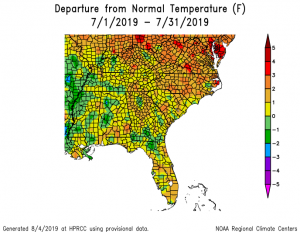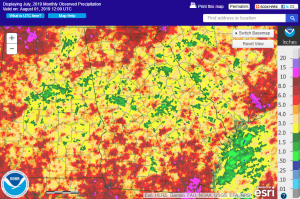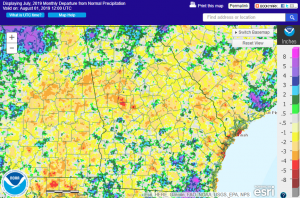Temperatures across most of Georgia in July 2019 were warmer than normal across the state. Most areas of the state were also drier than normal, but Albany was just above normal and Alma was more than 2 inches wetter than normal, mainly due to heavy rain which occurred on July 4 and 5.
In Atlanta, the monthly average temperature was 82.2 degrees F (2.0 degrees above normal), in Athens 82.0 degrees F (1.4 degrees above normal), Columbus 83.3 F (0.8 degrees above normal), Macon 82.9 F (1.1 above normal), Savannah 84.1 F (1.7 above normal), Brunswick 84.1 F (1.2 above normal), Alma 83.1 F (1.0 above normal), Augusta 83.7 F (2.1 above normal), Albany 83.5 F (1.1 above normal), Rome 81.8 F (2.2 above normal), and Valdosta 81.7 F (0.3 degrees above normal).
Savannah reported a new daily record high temperature of 101 F on July 3, breaking the old record of 98 F set in 1993 and earlier years. Macon reported a new record low minimum temperature on July 25, when the temperature dropped to 60 F, far surpassing the old record of 64 F set in 2009. Several cities set new record high minimum temperatures, including Atlanta (July 4, 77 F surpassed 76 F set in 2016), Alma (July 10, 78 F exceeded 75 F set in 2005), and Brunswick (July 3, 80 F surpassed 79 F set in 2018). A number of temperature records were also tied this month.
Precipitation was drier than normal in most of the state, with a few spots that got hit with heavy rains. The wettest parts of the state were over the Okefenokee Swamp, near Rome in the northwest, and the mountains in Rabun County in the northeast. The highest monthly total precipitation from National Weather Service reporting stations was 7.55 inches in Alma (2.22 inches above normal) and the lowest was in Athens with 1.37 inches (3.10 inches below normal). Atlanta received 2.06 inches (3.21 inches below normal), Columbus 3.92 inches (0.84 below normal), Macon 3.40 inches (1.55 below normal), Savannah 3.69 inches (1.91 below normal), Augusta 1.39 inches (2.94 below normal), Brunswick 1.72 inches (2.36 below normal), Rome 4.20 inches (0.12 below normal), Albany 5.56 inches (0.10 above normal) and Valdosta 3.71 inches (2.92 inches below normal).
No daily rainfall records were set in July in Georgia.
The highest 24-hour rainfall total from CoCoRaHS observers in July was 6.46 inches observed near Loganville in Walton County on July 6, followed by 4.96 inches measured near Columbus in muscogee County on July 20. The highest monthly amount was 13.58 inches measured by an observer in Homeland in Charlton County, followed by 9.23 inches measured by an observer in Eastman in Dodge County and 9.17 inches measured near Cedartown in Polk County.
Drought conditions at the beginning of July gradually eroded over the month of July but pockets of moderate drought remained by the end of the month. A small area of severe (D2) drought occurred briefly along the southwest border with Alabama but was removed by the last week.
Severe weather occurred on thirteen days in July. No tornadoes were reported and only a couple of isolated hail reports were made; the rest were due to strong winds.
The dry conditions caused problems for some farmers who were hoping for more rain to fill soybeans and corn. Most corn was ready to harvest by the end of the month. Forage producers were delaying cutting to increase their yields in the dry conditions, although the hay was drying well once cut. Cotton also suffered from the dry conditions, leading to concerns about the fall yield due to uneven growth of bolls on the plants.
The outlook for August 2019 and for the August through October period shows that the temperatures for the next three months are expected to continue to be warmer than normal across the state. Precipitation shows no trend towards wetter or drier conditions for the 3-month period. A lot of the uncertainty depends on when the tropics wake up and start sending more weather systems towards the Southeast, which should happen later in August and September as the peak tropical season approaches.
For more information please see the “Climate and Agriculture” blog at https://site.extension.uga.edu/climate/. We are also on Facebook at SEAgClimate and on Twitter at @SE_AgClimate. Please feel free to email your weather and climate impacts on agriculture to share on the blog to pknox@uga.edu.


